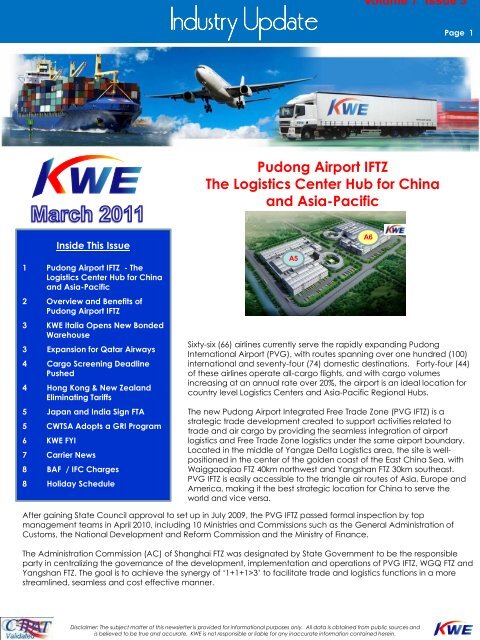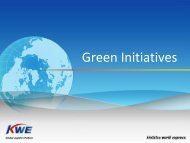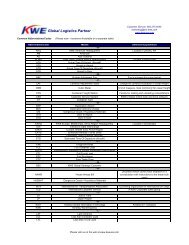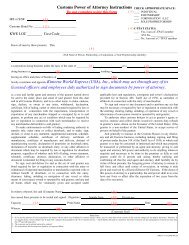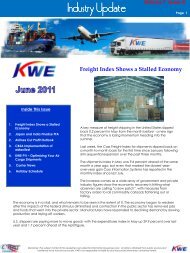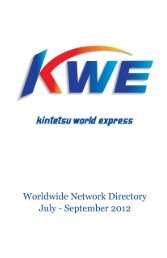KWE Industry Update - Kintetsu World Express (USA), Inc.
KWE Industry Update - Kintetsu World Express (USA), Inc.
KWE Industry Update - Kintetsu World Express (USA), Inc.
You also want an ePaper? Increase the reach of your titles
YUMPU automatically turns print PDFs into web optimized ePapers that Google loves.
<strong>Industry</strong> <strong>Update</strong><br />
Page<br />
Volume 7 Issue 3<br />
1<br />
Pudong Airport IFTZ<br />
The Logistics Center Hub for China<br />
and Asia-Pacific<br />
Inside This Issue<br />
1 Pudong Airport IFTZ - The<br />
Logistics Center Hub for China<br />
and Asia-Pacific<br />
2 Overview and Benefits of<br />
Pudong Airport IFTZ<br />
3 <strong>KWE</strong> Italia Opens New Bonded<br />
Warehouse<br />
3 Expansion for Qatar Airways<br />
4 Cargo Screening Deadline<br />
Pushed<br />
4 Hong Kong & New Zealand<br />
Eliminating Tariffs<br />
5 Japan and India Sign FTA<br />
5 CWTSA Adopts a GRI Program<br />
6 <strong>KWE</strong> FYI<br />
7 Carrier News<br />
8 BAF / IFC Charges<br />
8 Holiday Schedule<br />
A5<br />
Sixty-six (66) airlines currently serve the rapidly expanding Pudong<br />
International Airport (PVG), with routes spanning over one hundred (100)<br />
international and seventy-four (74) domestic destinations. Forty-four (44)<br />
of these airlines operate all-cargo flights, and with cargo volumes<br />
increasing at an annual rate over 20%, the airport is an ideal location for<br />
country level Logistics Centers and Asia-Pacific Regional Hubs.<br />
The new Pudong Airport Integrated Free Trade Zone (PVG IFTZ) is a<br />
strategic trade development created to support activities related to<br />
trade and air cargo by providing the seamless integration of airport<br />
logistics and Free Trade Zone logistics under the same airport boundary.<br />
Located in the middle of Yangze Delta Logistics area, the site is wellpositioned<br />
in the center of the golden coast of the East China Sea, with<br />
Waiggaoqiao FTZ 40km northwest and Yangshan FTZ 30km southeast.<br />
PVG IFTZ is easily accessible to the triangle air routes of Asia, Europe and<br />
America, making it the best strategic location for China to serve the<br />
world and vice versa.<br />
A6<br />
After gaining State Council approval to set up in July 2009, the PVG IFTZ passed formal inspection by top<br />
management teams in April 2010, including 10 Ministries and Commissions such as the General Administration of<br />
Customs, the National Development and Reform Commission and the Ministry of Finance.<br />
The Administration Commission (AC) of Shanghai FTZ was designated by State Government to be the responsible<br />
party in centralizing the governance of the development, implementation and operations of PVG IFTZ, WGQ FTZ and<br />
Yangshan FTZ. The goal is to achieve the synergy of „1+1+1>3‟ to facilitate trade and logistics functions in a more<br />
streamlined, seamless and cost effective manner.<br />
Disclaimer: The subject matter of this newsletter is provided for informational purposes only. All data is obtained from public sources and<br />
is believed to be true and accurate. <strong>KWE</strong> is not responsible or liable for any inaccurate information contained herein.
Page 2<br />
Overview and Benefits of Pudong Airport Integrated FTZ<br />
Unified Policy<br />
The departments of customs, inspection and<br />
quarantine, foreign exchange, port service, AC,<br />
commerce and industry, taxation, and public<br />
security shall set up their offices or send officers into<br />
PVG IFTZ. Other relevant administrative<br />
departments shall regularly attend to official duties<br />
at worksite in PVG IFTZ led by AC, assisting the<br />
development of the enterprises in FTZ with concise<br />
procedures, transparency and integrated services<br />
between the 3 FTZs.<br />
Unified Process<br />
A vital process is the collaboration of customs<br />
systems so WGQ FTZ, PVG IFTZ and Yangshan FTZ<br />
are all utilizing H2000 and H-Book Customs Systems.<br />
This system facilitates the sharing of relevant<br />
information and electronic exchange between the<br />
enterprise and customs to achieve „Paperless<br />
Clearance‟. By taking advantage of electronic<br />
data interchange (EDI) across the 3 FTZs, the<br />
customs clearance process will become quicker,<br />
resulting in a more efficient cargo flow.<br />
Goods subject to inspection that are sold or<br />
transferred within PVG IFTZ, WGQ FTZ and Yangshan<br />
FTZ are exempted from inspection and quarantine.<br />
<strong>KWE</strong>’s Involvement with the<br />
Implementation of Pudong IFTZ<br />
• Trusted Partner – <strong>KWE</strong> was honored to be<br />
selected as a pilot run partner and now resides on<br />
the ground floor of the A6 Bldg which was<br />
reserved for <strong>KWE</strong>.<br />
• Customs Process – <strong>KWE</strong> was involved in the<br />
“brain storming” sessions with Customs to establish<br />
new process<br />
• Voice of Customers – <strong>KWE</strong> was able to share<br />
experiences and expectations fro our large<br />
corporate customers<br />
• Pilot U-Turn – <strong>KWE</strong> successfully executed the<br />
first U-turn shipment into PVG airport IFTZ on July<br />
28, 2010<br />
• Pilot Bonded Air – <strong>KWE</strong> successfully executed<br />
“Bonded Air” PVG IFTZ to Chongqing EPZ<br />
Shared Resources<br />
Two separate buildings house the Service, Management and Business Centers. Every enterprise established in the<br />
Yangshan FTZ or WGQ FTZ may file with customs and set up branches in PVG IFTZ. Government related<br />
administrative offices and branches set up in the building to provide in-zone enterprises include customs,<br />
inspection and quarantine, industry and commerce, taxation, bank and post. Bonded equipment may also be<br />
shared within the 3 FTZs.<br />
Expanded Functions<br />
One of the most distinctive benefits of the PVG IFTZ is the ability to combine both FTZ and BLP (Bonded Logistics<br />
Park) functions. FTZ support services include international goods transit, procurement and distribution, entrepot<br />
trade, maintenance and testing, financing lease, warehousing and logistics, export processing, commodity<br />
exhibition trade, establishment of light manufacturing and assembly plant and tax rebates to local supplier after full<br />
export of shipment.<br />
BLP is devoted to the logistics functions of procurement and distribution of goods and other bonded logistics<br />
services. BLP also has more preferential tax policies. Tax rebates occur immediately after entry to the park and<br />
foreign exchange management is more relaxed - the local enterprises purchase the goods from the park and can<br />
pay to the enterprises within the park or abroad to outside enterprises.<br />
PVG IFTZ supports the services and functions offered in both FTZ & BLP. Enterprise can set up its logistics, distribution<br />
and trade functions in PVG IFTZ and its suppliers can enjoy tax refunds upon arrival of the supplies in PVG IFTZ.<br />
Seamless Integration of Airport and DC Operations<br />
The Pudong IFTZ is connected seamlessly to PVG International Airport, allowing a swift and safe transfer of import<br />
and export shipments across the airport and the DC warehouse.<br />
As PVG IFTZ is formed as an integrated part of PVG Airport, shipments from IFTZ to PVG airport does not involve<br />
data transmission in Customs system for bonded shipment. Whereas Yangshan FTZ and WGQ FTZ, separate<br />
Customs zones, will requires bonded transfer of goods movement and data transmission. As the Customs system in<br />
China only allows data transmission twice for bonded shipments, the PVG IFTZ is able to support bonded air to other<br />
China cities more seamlessly than Yangshan and WGQ FTZs.<br />
Disclaimer: The subject matter of this newsletter is provided for informational purposes only. All data is obtained from public sources and is<br />
believed to be true and accurate. <strong>KWE</strong> is not responsible or liable for any inaccurate information contained herein.
<strong>KWE</strong> Italia Opens New Bonded<br />
Warehouse<br />
Page 3<br />
On July 01, 2010 <strong>KWE</strong> Italia was awarded with a<br />
6 year contract for warehousing and 3PL activity<br />
by a multinational account involved in the high<br />
tech industry. In order to comply with their<br />
requirements, <strong>KWE</strong> Italia opened an 8.000 m²<br />
bonded warehouse in Magliano dei Marsi<br />
(Rome area).<br />
Our customer is presently occupying 5,000m²<br />
including 2,000 m²of temperature controlled<br />
area, where we store chemical products. The<br />
remaining portion of the warehouse has been<br />
assigned to a leading Italian manufacturer of<br />
solar panels. An additional 2000 m² is expected<br />
to open soon in the same area as a result of<br />
demand for warehousing space in the market.<br />
<strong>KWE</strong> Italia is also planning to open an additional<br />
3,000m² bonded warehouse in Rieti (Rome<br />
area) aligning with our strategy to further<br />
implement the logistics activity on the Italian<br />
territory.<br />
This new project will go live during Q1, 2011.<br />
Expansion for Qatar Airways<br />
On March 6 th , Qatar Airways will newly launch thrice-weekly services to Stuttgart. Also, the airline has added two<br />
additional weekly flights to Frankfurt and four more to Munich. The carrier will be flying to Germany 33 times<br />
each week.<br />
CEO Akbar Al Baker stated “By adding these extra flights, we are responding to strong demand for additional<br />
capacity on the Munich and Frankfurt routes. The strengthened services will foster new business and tourism links<br />
with the largest economy in the European Union."<br />
Since February 2010, Qatar has launched 12 new routes including flights to Budapest, Tokyo, Barcelona, Sao<br />
Paulo, Buenos Aires, Phuket and Hanoi. The carrier is planning to expand aggressively in the next two years by<br />
adding 19 more destinations and more than 20 new aircrafts.<br />
Disclaimer: The subject matter of this newsletter is provided for informational purposes only. All data is obtained from public sources and is<br />
believed to be true and accurate. <strong>KWE</strong> is not responsible or liable for any inaccurate information contained herein.
Page 4<br />
Cargo Screening Deadline Pushed Up<br />
The Transportation Security Administration (TSA) has announced an<br />
accelerated deadline of Dec 31, 2011 for 100% cargo screening on all<br />
inbound U.S. international passenger flight.<br />
Last summer, TSA, testified before Congress that it would take until 2013<br />
before an all-cargo screening policy on international passenger aircraft<br />
could be effectively put into place. However, in an e-mail to freight<br />
forwarders and shippers, the organization pointed to “recent global<br />
events” as justification for pushing the deadline up by a full two years.<br />
This announcement will have an immediate effect on the air cargo industry beyond just the increased cost of<br />
screening more packages since it will require earlier cut-offs for cargo, reducing some of the expedited<br />
advantage of airfreight. The mandate could possibly provide further advantage to large forwarders and<br />
integrators over mid-size and small forwarders, and it may have more shippers considering ocean cargo as an<br />
alternative.<br />
Though December is nearly a full year away, that still doesn‟t leave a lot of time for the myriad changes that<br />
need to be made before screening can be implemented. One of the largest hurdles will be coordinating<br />
security measures in origin countries, which involves making sure the TSA, airlines and each country are on the<br />
same page.<br />
Many feel that the TSA requirement just may not be feasible. A percentage based on origin can be achieved<br />
by December, but not 100%– we‟re more likely looking within the 75% range. This is an important part of cargo<br />
and national security, but the TSA will have to move much faster than they have in the past with establishing<br />
rules and guidelines if they want to achieve 100 percent by this deadline.<br />
Hong Kong & New Zealand<br />
Eliminating Tariffs<br />
The New Zealand-Hong Kong, China Closer Economic<br />
Partnership Agreement (the “CEP”) was signed in Hong Kong<br />
on March 29, 2010 and entered into effect on January 1, 2011.<br />
Hong Kong is New Zealand‟s 9th largest export destination and<br />
the total bilateral merchandise trade between the two<br />
countries amounted to about HK$6.5 billion ($837 million) in<br />
the first nine months of 2010, with average annual growth rate<br />
of 2.7% from 2005 to 2009.<br />
Based on the average merchandise trade figures in recent<br />
years, Hong Kong's annual tariff saving is estimated to be<br />
about HK$7 million (USD$900,900), according to the figures<br />
earlier released on the Hong Kong government's website.<br />
Under the Closer Economic Partnership Agreement (CEP) signed in March, New Zealand will phase out its import<br />
tariffs on all goods originating in Hong Kong and all of Hong Kong‟s exports to New Zealand will be tariff-free within<br />
six years. More than 90% of New Zealand‟s tariff lines will become duty free within two years. Hong Kong has<br />
committed to cut all tariffs on products from New Zealand and remove 64% of export tariffs immediately after the<br />
CEP Agreement begins. This will cover certain electrical machinery and equipment, sound recording and<br />
reproducing apparatus and wooden items. The agreement also covers the six industries in which Hong Kong<br />
specializes and is promoting further development, namely education services, medical services, testing and<br />
certification services, environmental services, innovation and technology, and cultural and creative industries.<br />
This deal will help New Zealand businesses boost trade with Hong Kong and take further advantage of growing<br />
opportunities in the region. The CEP also complements New Zealand‟s Free Trade Agreement (FTA) with China and<br />
enhances the potential for Hong Kong to be used as a platform for trade into Mainland China.<br />
It contains measures to improve business flows and promote cooperation in a broad range of economic areas of<br />
mutual interest, and is supported by legally-binding side agreements on Labor and Environment that are in line with<br />
New Zealand‟s broader objectives for sustainable development. A legally-binding side agreement was also<br />
secured to negotiate an Investment Protocol within two years of entry into force.<br />
Disclaimer: The subject matter of this newsletter is provided for informational purposes only. All data is obtained from public sources and is<br />
believed to be true and accurate. <strong>KWE</strong> is not responsible or liable for any inaccurate information contained herein.
Japan and India have signed a free trade agreement to<br />
eliminate import tariffs on most products traded between<br />
the two giant Asian economies in hopes to "promote the<br />
liberalization and facilitation of trade and investment<br />
between the two countries" and "further vitalize both<br />
economies by strengthening reciprocal economic ties in<br />
wide-ranging fields," the Japanese government<br />
announced in a statement.<br />
The FTA, formally called the Comprehensive Economic<br />
Partnership Agreement between Japan and the<br />
Republic of India, will be signed in Tokyo by Japanese<br />
Foreign Minister Seiji Maehara and Indian Commerce<br />
and <strong>Industry</strong> Minister Anand Sharma.<br />
Japan and India Sign FTA Hoping to<br />
Remove Trade Barriers<br />
The signing comes after about four years of negotiations between the countries. The Japan-India FTA will eliminate<br />
import tariffs on about 94 percent of bilateral trade by value within 10 years. Although it has been noted that some<br />
of Japan's fiercely protected agricultural commodities, such as rice, wheat and some dairy products will be exempt<br />
from the tariff cut.<br />
Under the pact, the two countries will continue discussions over whether to allow Indian nationals to work in Japan<br />
as nurses and caregivers as Japan's population continues to shrink and age. Regarding service trade, Delhi will relax<br />
its restrictions on Japanese investment in retailers and telecommunications.<br />
Japan and India are now Asia's second- and third-largest economies after China. According to Japanese<br />
government figures, Japan exported $7.2 billion worth of products to India and imported $4.2 billion worth of goods<br />
from the South Asian country in 2009.<br />
For Japan, the FTA with India will be the 12th such trade pact. Japan has so far signed FTAs with 10 countries --<br />
Singapore, Mexico, Malaysia, Chile, Thailand, Indonesia, Brunei, the Philippines, Switzerland and Vietnam – and with<br />
the 10-member Association of Southeast Asian Nations.<br />
ASEAN groups Brunei, Cambodia, Indonesia, Laos, Malaysia, Myanmar, the Philippines, Singapore, Thailand and<br />
Vietnam.<br />
For Japan, the FTA with India will be the first such trade pact since the Democratic Party of Japan took power<br />
following a landslide victory in general elections in August 2009.<br />
Page 5<br />
CWTSA Adopts a GRI Program<br />
Container shipping lines in the Canada Westbound Transpacific Stabilization Agreement (CWTSA) have adopted a<br />
GRI program effective April 1, 2011.<br />
The Member Lines in the CWTSA will raise rates as per below from all Canadian origin ports and IPI points to all<br />
destinations:<br />
Dry commodities<br />
• 20‟ container (TEU) US$160.00<br />
• 40‟ container (FEU) US$200.00<br />
CWTSA also intends to implement rate increases for refrigerated commodities effective April 1, 2011 by US$240.00 per<br />
20' container and US$300.00 per 40' container. These increases will apply from all Canadian origin ports and IPI points<br />
to all destinations.<br />
CWTSA is a discussion forum of 8 major container shipping lines serving the trade from ports and inland points in<br />
Canada to destinations throughout Asia.<br />
Disclaimer: The subject matter of this newsletter is provided for informational purposes only. All data is obtained from public sources and is<br />
believed to be true and accurate. <strong>KWE</strong> is not responsible or liable for any inaccurate information contained herein.
Page 6<br />
<strong>KWE</strong> FYI<br />
<strong>KWE</strong> FYI is a section within our <strong>Industry</strong> <strong>Update</strong> featuring items and<br />
trends of interest relevant to transportation and logistics, global trade<br />
and future developments that may have impact in these areas<br />
Ports Test New Technologies<br />
Hoping to Reduce Vessel<br />
Emissions<br />
This spring 2011, an innovative air pollution-reduction device called the "seawater scrubber" will be<br />
tested for the first time on a container ship visiting Southern California in a $3.4 million project cosponsored<br />
by the ports of Los Angeles and Long Beach.<br />
The seawater scrubber, supplied through a partnership between Bluefield Holdings <strong>Inc</strong>. and<br />
Krystallon, Ltd., features advanced emission control technology in which seawater is used to scrub, or<br />
filter, contaminants from a ship's auxiliary engines and boiler before exiting the exhaust stack of a<br />
ship. Once solid carbon contaminants have been removed, the seawater used during the scrubbing<br />
process is then treated and cleansed before being discharged. The solid contaminants are<br />
contained and collected for later disposal.<br />
"The seawater scrubbing technology shows tremendous long-term potential for reducing emissions at<br />
our ports and improving the environment," said Port of Los Angeles Executive Director Geraldine<br />
Knatz, Ph.D. "We're excited about testing this innovative equipment and evaluating its promise for<br />
more widespread use."<br />
"Many of the ocean carriers are looking for ways to reduce their vessels' emissions and projects like<br />
this are an ideal way to demonstrate the effectiveness of new technology to the industry," said Port<br />
of Long Beach Executive Director Richard D.Steinke.<br />
Funded in part by a $1.65 million grant from the Technology Advancement Program (TAP), a joint<br />
initiative of the ports of Los Angeles and Long Beach, the seawater scrubber filtering technology will<br />
be tested on an APL container vessel. As part of the three-year demonstration project, the scrubber<br />
technology on the APL test vessel will be evaluated over a one-year period during the ship's calls to<br />
the San Pedro Bay ports. It's expected to result in air emission reductions of approximately 80-85<br />
percent in diesel particulate matter, 99.9 in sulfur oxide emissions, more than a 90 percent decrease<br />
in volatile organic compounds (VOC) and another 10 percent reduction in nitrogen oxide pollutants.<br />
Diesel particulate matter is classified in the state of California as a toxic air contaminant based upon<br />
its potential to cause health problems and cancer. Sulfur oxides, VOC and nitrogen oxides are gases<br />
that contribute to smog.<br />
"APL has long engaged with industry, the public sector and academia in search of new ways to<br />
mitigate the environmental impacts of global trade," said Earl Agron, Vice President of Environmental<br />
Affairs at APL. "This latest effort with the ports of Los Angeles and Long Beach is in the same spirit of<br />
cooperation and discovery.“<br />
TAP was created as part of the San Pedro Bay Ports Clean Air Action Plan (CAAP), and focuses on<br />
accelerating the commercial availability of new clean air strategies to reduce air pollution. Jointly<br />
funded by the ports of Los Angeles and Long Beach, TAP has provided more than $5 million in project<br />
funding since the program began in 2007. Recently, the U.S. Environmental Protection Agency<br />
bestowed the 2010 Clean Air Technologies Award to the ports for TAP.<br />
Disclaimer: The subject matter of this newsletter is provided for informational purposes only. All data is obtained from public sources and<br />
is believed to be true and accurate. <strong>KWE</strong> is not responsible or liable for any inaccurate information contained herein.
New Emirates SkyCargo Trade<br />
Route Will Boost Iraq Business<br />
Carrier News<br />
Emirates SkyCargo - the freight division of Dubai-based<br />
airline Emirates – has added further momentum to the<br />
surge in trading through Iraq with the commencement of<br />
its new service to Basra which began on February 2.<br />
As the country‟s recovery gathers pace following a period<br />
of sustained investment by major global corporations,<br />
Emirates SkyCargo will be transporting 130 tons of freight<br />
per week between Dubai and Iraq‟s largest port,<br />
strategically located close to key oil fields. In addition to<br />
transporting equipment for oil and petroleum companies<br />
in the belly-hold of an Airbus A330-200, it expects to carry<br />
a diverse range of goods from all corners of the globe,<br />
including perishable foodstuffs, medical products, car<br />
parts, garments, textiles and various electronic items such<br />
as mobile phones.<br />
With many multinational companies committed to the redevelopment of Iraq‟s economy and infrastructure, the<br />
trading potential is very clear, Iraq‟s recovery is already well under way and this new trade route will create further<br />
opportunity for growth, with businesses now able to establish trade links with the UAE and the other 65 countries on<br />
the global network.<br />
Basra will be the first route added to the Emirates network in 2011, becoming the airline‟s 110th international<br />
destination. Geneva and Copenhagen will follow on June 1 st and August 1 st respectively and as the airline‟s fleet of<br />
152 aircraft grows after the delivery of several of the 200 aircraft it has on order, further route announcements are<br />
expected.<br />
The service will operate in a three-class configuration - First Class, Business Class and Economy Class - on<br />
Wednesday, Thursday and Saturday and in a two-class configuration - Business Class and Economy Class - on<br />
Mondays. EK945 will depart Dubai at 13:45 hours and touch down at Basra International Airport at 14:45 hours the<br />
same day. At 16:15 hours, return flight EK 946 will depart Basra touching down in Dubai at 19:10 hours. The service<br />
connects seamlessly with key industry hubs in the US and Europe.<br />
Page 7<br />
American Airlines Launches New Service to Haneda Airport<br />
American Airlines (AA) has launched a daily service to Tokyo‟s<br />
Haneda Airport from New York‟s JFK Airport, the first U.S. airline to do<br />
so from the continental United States. The B777 passenger service<br />
follows an open skies agreement between the U.S. and Japan.<br />
AA is now serving both Tokyo‟s Narita and Haneda airports from New<br />
York. The carrier expects to move consignments of flowers from South<br />
America as well as seafood from the east coast of the U.S. on the<br />
westbound trans-Pacific flight. In the return direction, auto parts and<br />
construction equipment are likely commodities, connecting through<br />
to AA‟s Latin American destinations such as Rio de Janerio and Sao<br />
Paulo, Brazil.<br />
Haneda re-started scheduled international flights for the first time in<br />
more than 30 years after the bilateral open-skies agreement, which<br />
was signed in October. The airport has seen a fivefold increase in<br />
cargo traffic since it opened a new international terminal and<br />
opened a fourth runway toward the end of last year.<br />
A new temperature-controlled facility at Tokyo International Air<br />
Cargo Terminal (TIACT) enables the airport to export fish, fruit and<br />
other fresh produce.<br />
“Our new flight opens important new<br />
daily trade lane opportunities for our<br />
customers, with connections throughout<br />
the United States and Latin America from<br />
Asia and new connections throughout<br />
Japan from Haneda”<br />
Dave Brooks<br />
President of American Airlines Cargo<br />
Disclaimer: The subject matter of this newsletter is provided for informational purposes only. All data is obtained from public sources and<br />
is believed to be true and accurate. <strong>KWE</strong> is not responsible or liable for any inaccurate information contained herein.
Page 8<br />
<strong>Update</strong>: Bunker Adjustment Factor (BAF) and Inland Fuel Charge (IFC)<br />
WESTBOUND (from <strong>USA</strong> to Asian destinations)<br />
January 01 through March 31, 2011<br />
20’ dry 40’-45’ dry 20’ reefer other reefer<br />
BAF – West Coast 420 525 591 739<br />
BAF – East Coast 834 1042 1110 1387<br />
IFC – Pure truck 72 72 72 72<br />
IFC – Truck/Rail 248 248 248 248<br />
EASTBOUND (from Asian origins to <strong>USA</strong>)<br />
January 01 through March 31, 2011<br />
per 20’ per 40’ per 40HQ per 45’<br />
BAF – West Coast 294 368 414 466<br />
BAF – East Coast 582 727 818 920<br />
IFC-Truck 72 72 72 72<br />
IFC-RIPI 124 124 124 124<br />
IFC-IPI 248 248 248 248<br />
March Holiday Schedule<br />
17 St. Patrick‟s Day All offices open<br />
21 Human Rights Day – South Africa Skeleton Staff<br />
Correction<br />
Please note that there was an error in the Beaujolais Nouveau wine article which was published in<br />
the January 2011 edition of the <strong>Industry</strong> <strong>Update</strong> – <strong>KWE</strong> transported 1,500,000 bottles of wine,<br />
not 1,500.00.<br />
Disclaimer: The subject matter of this newsletter is provided for informational purposes only. All data is obtained from public sources<br />
and is believed to be true and accurate. <strong>KWE</strong> is not responsible or liable for any inaccurate information contained herein.


